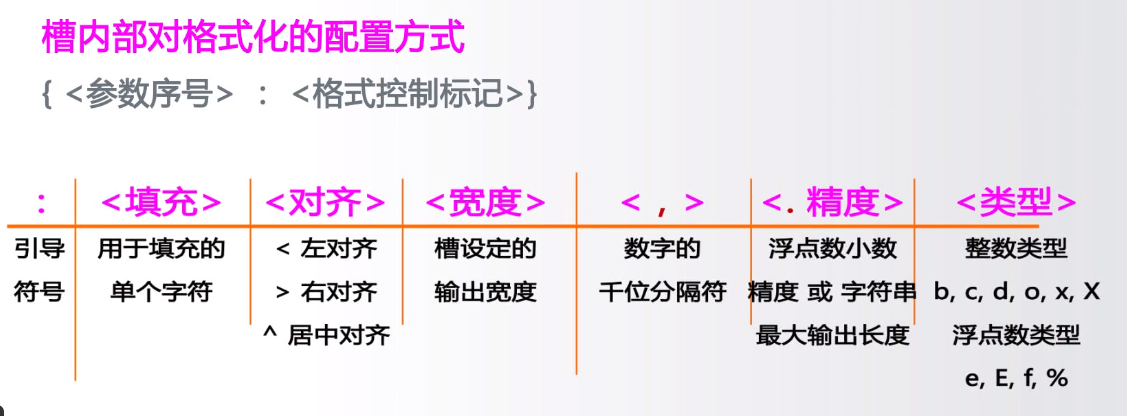字符串处理函数 >>> s='bav sj ' >>> len(s) 7 >>> str([1,2])#与eval 正好相反 '[1, 2]' >>> hex(10)#转化为16进制 '0xa' >>> oct(10)#转化为8进制 '0o12
a = eval(input())
b = hex(a)
c = b[2:]
print(b,c)
>>> 'wFWEGWR'.lower()#全转化为小写。.upper 为大写 'wfwegwr' >>> 'A,B,C'.split(',')#str根据sep被分割的部分组成 ['A', 'B', 'C'] >>> 'a fe a gta '.count('a')子串在原串出现的次数 3
print(s.center(8))
hello #左侧1空格,右侧2空格
>>> 'python'.replace('n','123')#所有n都会被替代为123 'pytho123'
#在一个20宽度的字符串中,让python 居中
>>> 'python'.center(20,'=')
'=======python======='
>>> 'python'.center(19,'=')
'=======python======'
str.strip(chars)#从str 里去掉在其左侧和右侧chars中列出的字符
>>> "= python ".strip("=n")
' python '
>>> 'rwrgt'.strip('r') 'wrgt' >>> '1python'.strip('t') '1python' >>> '123456'.strip("123") '456'
s = 'hello'
print(s.capitalize())
Hello
print(' okok '.strip())
okok #去空格
print(s.rjust(8))
Right-justify a string, padding with spaces; prints " hello"
获得用户输入的一个正整数输入,输出该数字对应的中文字符表示。 0到9对应的中文字符分别是:零一二三四五六七八九 a = input() b=[] data = {'1':'一', '2':'二','3':'三','4':'四','5':'五','6':'六','7':'七','8':'八','9':'九', '0':'零'}; for i in a: b.append(data[i])#因为1 2 3 都加了引号,所以i 为字符,那么data[0]错,data['0'] 对的 print(b) c = ''.join(b)#去掉格式 print(c) 62455 ['六', '二', '四', '五', '五'] 六二四五五 a = input() b=[] data = ['零','一', '二','三','四','五','六','七','八','九']; for i in a: x = eval(i) b.append(data[x]) c= ''.join(b) print(c)
str.join(it)# 在it 变量除最后元素外每个元素后增加一个str >>> ",".join("1356")#主要用于字符串的分隔 '1,3,5,6'
Unicode 字符串的编码方式 统一字符编码,覆盖几乎所有字符的编码方式 从0到1114111(0x10FFFF)空间,每个编码对应一个字符 python 字符串中每个字符都是Unicode 编码字符 chr(u)#u为Unicode 编码,返回其对应的字符 >>> chr(9800) '♈' ord(x)# x 为字符,返回其对应的Unicode 编码 >>> ord('♈') 9800 #打印12星座 >>> for i in range(12): print(chr(9800+i),end='') ♈♉♊♋♌♍♎♏♐♑♒♓
>>> s="sgfter ' " >>> len(s) 9 、>>> t = s+'efre' >>> t "sgfter ' efre" >>> t*3 "sgfter ' efresgfter ' efresgfter ' efre" >>> for char in name: print(char) >>> x = "123" >>> y="012345" >>> x in y#x是y的子串吗? True >>> x = "16" >>> x in y False #今天星期几? westr = "星期一星期二星期三星期四星期五星期六星期日" id = eval(input()) pos = (id-1)*3 print(westr[pos:pos+3]) westr = "一二三四五六日" id = eval(input()) print("星期"+westr[id-1])

>>> "{0:=^20}".format("python") '=======python=======' >>> "{0:=^20}".format("python") '=======python=======' >>> "{0:*>20}".format("NOI") '*****************NOI' >>> "{:10}".format("feq") 'feq '#默认填充空格,左对齐,宽度为10
s='PYTHON' print("{0:3}".format(s))
{0:3}表示输出的宽度是3,但如果字符串超过长度3,则以字符串长度显示。PYTHON
>>> "{0:,}".format(46532.396)
'46,532.396'
>>> "{0:,.2f}".format(1233.369)
'1,233.37'
import math
a = eval(input())
b = pow(a,0.5)
print("{0:+>30.3f}".format(b))
10
+++++++++++++++++++++++++3.162
b :二进制
c:字符
d:十进制
o:八进制
x:16进制
X:大写16进制
#进制转化
10进制转化为其他的
>>> print("{:b}".format(15))
1111
>>> print("{:o}".format(15))
17
>>> print("{:x}".format(15))
f
其他的转化为10进制
>>> int("40",16)
64
>>> int('110',2)
6
>>> int('100',8)
64
#16进制到2进制 >>> bin(0xa) '0b1010' >>>
#2进制到16进制 >>> hex(0b1001) '0x9'
>>> "{0:b},{0:c},{0:d},{0:o},{0:x},{0:X}".format(451) '111000011,ǃ,451,703,1c3,1C3' >>> "{0:e},{0:E},{0:f},{0:%}".format(3.14) '3.140000e+00,3.140000E+00,3.140000,314.000000%'
a = eval(input()) print("{:-^20}".format(pow(a, 3)))#超过20位的以结果宽度为准
获得用户输入的一个整数a,计算a的平方根,保留小数点后3位,并打印输出。 输出结果采用宽度30个字符、右对齐输出、多余字符采用加号(+)填充。 如果结果超过30个字符,则以结果宽度为准。 a = eval(input()) print("{:+>30.3f}".format(pow(a,0.5)))
获得输入的一个字符串s,以字符减号(-)分割s,将其中首尾两段用加号(+)组合后输出。 a = input() s = a.split('-') print("{}+{}".format(s[0],s[-1]))
a = input()
s = a.split('-')
print(s[0],'+',s[-1],sep='')